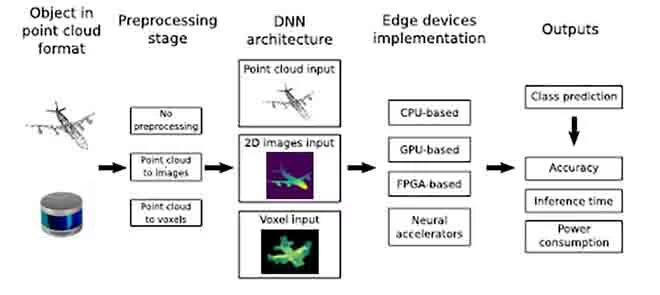Characterizing Deep Neural Networks on Edge Computing Systems for Object Classification in 3D Point Clouds
The escalating need for cutting-edge technology to detect and pinpoint objects is rapidly growing across multiple domains, spanning from robotics to surveillance systems. Light Detection And Ranging (LIDAR), favored for its precision in any environment, surpasses traditional cameras hindered by darkness or rain in accurately locating objects, addressing challenges in determining object positions. In real-time, LIDAR generates substantial data volumes. Deep Neural Networks (DNNs) play a vital role in managing this data effectively.
The paper evaluates DNN algorithms and advanced edge processing elements for classifying objects in 3D point clouds, covering performance, accuracy, and power consumption. It features state-of-the-art DNN architectures using point clouds, outlining the dataset and frameworks for training and inference. Innovative methods include transforming 3D data into 2D images for edge devices, adapting DNNs for quantized data, and designing custom IoT nodes with integrated processors and accelerators.
It compares three DNN architectures based on point cloud input, offering insights into inference times and classification accuracy. PointNet processes point clouds directly with high data precision but with increased computational costs. MVDMNet generates 2D images using statistical projection and multi-view methods. VoxNet classifies 3D objects with low resolution, using voxel grids and 2D convolutions for feature extraction.
Various platforms were used to compare three DNN architectures in edge computing, each offering specific advantages. Desktop PCs serve as performance benchmarks, while CPU-based devices like Raspberry Pi and custom IoT edge nodes offer flexibility. GPU-based devices like NVIDIA Jetson boards utilize parallel processing for DNN tasks. FPGA-based devices like Xilinx PYNQ-Z1 provide customizable circuits for optimization. Specialized neural accelerators, such as Coral EdgeTPU, Intel Movidius Neural Compute Stick, and Rockchip AI Stick, prioritize energy efficiency. TensorFlow was chosen as the training framework on desktop PCs, optimized for deployment on each platform. Each platform caters to different edge computing needs, with unique advantages in performance, power efficiency, and DNN compatibility.
Classification accuracy varies based on DNN data type handling, with quantization sometimes reducing accuracy. Neural accelerators achieve the best inference times at 0.21ms, notably Coral EdgeTPU USB due to its 8-bit integer data type. However, devices with neural accelerators may require a host, increasing overall power consumption. The preprocessing time differs across architectures, with PointNet needing none but having longer inference times and larger model sizes. MVDMNet has the highest preprocessing times, while VoxNet offers low preprocessing times (best: 1.36ms) and reduced inference times (best: 2.12ms). Neural accelerators are the most power-efficient, but the host's additional power consumption must be considered. Devices like the Cookie Coral platform and Coral DevBoard, which integrate a CPU with a neural accelerator, are suitable for IoT edge scenarios, consuming 0.22mJ of energy per inference without a host.
The experimental findings offer significant insights into how different DNN architectures perform across various edge technologies, aiding in the selection of appropriate architectures for specific applications. Factors such as accuracy, speed, preprocessing needs, and power consumption are considered. Potential future endeavors may involve the implementation of a real-world object detection system utilizing VoxNet on Cookie Coral, incorporating LIDAR technology.




